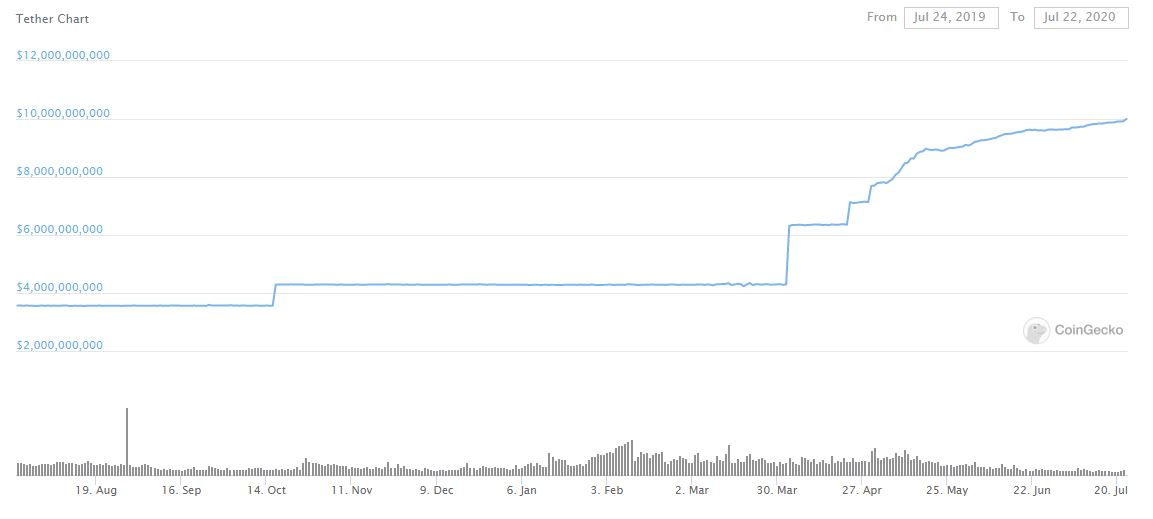The continuous growth of the most widely utilized stablecoin Tether (USDT) has pushed its total market capitalization above the coveted billion mark. On a monthly scale, the rise is even more impressive as it has doubled since March 2020.Tether Takes Over B Market CapTether, or as it was initially named – Realcoin, saw the light of day in 2014 as an innovative coin holding a stable value in an ever-fluctuating cryptocurrency market. The so-called stablecoin is pegged (almost) 1-to-1 with matching fiat currency (the US Dollar), and as a result, the price of the token remains at the same level – .Despite the sluggish start, the role of stablecoins, and by extent – Tether since it’s the largest, grew in time as traders were looking for less volatile assets in which they can store
Topics:
Jordan Lyanchev considers the following as important: AA News, Total Market Cap
This could be interesting, too:
Chayanika Deka writes Yuga Labs Secures Major Win as SEC Closes Investigation Without Charges
Andrew Throuvalas writes Bitcoin Soars Back To ,000 After BlackRock CEO Says “Buy The Dip”
Chayanika Deka writes XRP, SOL, and ADA Inclusion in US Crypto Reserve Pushes Traders on Edge
Chayanika Deka writes Why Arthur Hayes Is Bullish on Bitcoin Under Trump’s Economic Strategy
The continuous growth of the most widely utilized stablecoin Tether (USDT) has pushed its total market capitalization above the coveted $10 billion mark. On a monthly scale, the rise is even more impressive as it has doubled since March 2020.
Tether Takes Over $10B Market Cap
Tether, or as it was initially named – Realcoin, saw the light of day in 2014 as an innovative coin holding a stable value in an ever-fluctuating cryptocurrency market. The so-called stablecoin is pegged (almost) 1-to-1 with matching fiat currency (the US Dollar), and as a result, the price of the token remains at the same level – $1.
Despite the sluggish start, the role of stablecoins, and by extent – Tether since it’s the largest, grew in time as traders were looking for less volatile assets in which they can store value, without worrying for a sudden drop. The past year has been particularly impressive for Tether. Due to the continuously increasing demand, the company behind the token minted significant amounts rapidly.
As CryptoPotato reported, Tether went on a printing spree since March this year. The graph below illustrates the massive leaps of the market cap, which is a direct result of the amount of USDT in circulation since the price is always $1.

Tether continued growing in May as well. Somewhat inevitably, its market cap surpassed Ripple’s, and Tether became the third-largest cryptocurrency by that metric.
Earlier today, the company announced another major milestone – the total market capitalization of Tether now exceeds $10 billion. Interestingly, this means that the amount of USDT has doubled since March this year.
Tether’s Achievements
Although Tether has attracted some controversy throughout the years, company CTO Paolo Ardoino listed its accomplishments shortly after breaking above $10 billion. He described Tether as “strong resilient, transparent, regulated, registered with FinCEN, supports decentralization, and is a fundamental component of our crypto industry.”
Ardoino asserted that Tether is re-investing in the industry, by funding a layer 2 protocol – RGB, and investing in “promising startups and established businesses.” He also highlighted that USDT is available on several blockchains, including Bitcoin (via Omni), Ethereum, Tron, EOS, and Algorand.
Ardoino concluded that “USDT is probably the most used product in the entire crypto ecosystem, almost any exchange uses it – have listed pairs against it or offers custody.”
Does Tether Inflate Prices?
One of the highly discussed topics within the community is whether or not Tether has a direct impact on the prices of Bitcoin and other non-stablecoin digital assets. While arguments frequently surface pointing towards each direction, a recent study concluded that the issuances of stablecoins don’t artificially inflate the prices.
The two academics that compiled the research explained that Tether made a significant change in 2018. Before that year, all coins “created via grants were immediately distributed to Bitfinex and to other exchanges for trading in the secondary market.” After 2018, however, the Tether Treasury retains a fraction of all USDT.
By examining this “more precise measure of Tether inflow to the secondary market,” the total supply, and the shock effects on Bitcoin’s price, the study found “no systematic evidence that stablecoins issuance affects cryptocurrency prices.”
